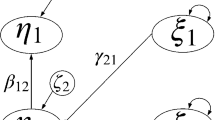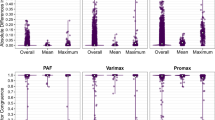Abstract
In order to study the effectiveness of factor analytic methods, a procedure was developed for computing simulated correlation matrices which are more similar to real data correlation matrices than are those matrices computed from the factor analysis structural model. In the present investigation, three methods of factor extraction were studied as applied to 54 simulated correlation matrices which varied in proportion of variance derived from a major factor domain, number of factors in the major domain, and closeness of the simulation procedure to the factor analysis structural model. While the factor extraction methods differed little from one another in quality of results for matrices more dissimilar to the factor analytic model, major differences in quality of results were associated with fewer factors in the major domain, higher proportion of variance from the major domain, and closeness of the simulation procedure to the factor analysis structural model.
Similar content being viewed by others
References
Burt, C. Factor analysis and canonical correlations.British Journal of Statistical Psychology, 1949,1, 95–106.
Cattell, R. B. and Dickman, K. A dynamic model of physical influences demonstrating the necessity of oblique simple structure.Psychological Bulletin, 1962,59, 389–400.
Cattell, R. B. and Sullivan, W. The scientific nature of factors: a demonstration by cups of coffee.Behavioral Sciences, 1962,7, 184–193.
Cliff, N. and Hamburger, C. D. The study of sampling errors in factor analysis by means of artificial experiments.Psychological Bulletin, 1967,68, 430–445.
Guttman, L. Image theory for the structure of quantitative variates.Psychometrika, 1953,18, 277–296.
Guttman, L. Some necessary conditions for common-factor analysis.Psychometrika, 1954,19, 149–161.
Guttman, L. The determinacy of factor score matrices with implications for five other basic problems of common-factor theory.British Journal of Statistical Psychology, 1955,8, 65–81.
Guttman, L. To what extent can communalities reduce rank?Psychometrika, 1958,23, 297–308.
Harris, C. W. Some Rao-Guttman relationships.Psychometrika, 1962,27, 247–263.
Holzinger, K. J. and Harman, H. H. Comparison of two factorial analyses.Psychometrika, 1938,3, 45–60.
Hotelling, H. Analysis of a complex of statistical variables into principal components.Journal of Educational Psychology, 1933,24, 417–441, 498–520.
Kaiser, H. F. Varimax solution for primary mental abilities.Psychometrika, 1960,25, 153–158.
Kaiser, H. F. A note on Guttman's lower bound for the number of common factors.British Journal of Statistical Psychology, 1961,14, 1–2.
Kaiser, H. F. and Caffrey, J. Alpha factor analysis.Psychometrika, 1965,30, 1–14.
Kelley, T. L. Essential traits of mental life.Harvard Studies in Education,26, Cambridge, Mass.: Harvard Univ. Press, 1935.
Lawley, D. N. The estimation of factor loadings by the method of maximum likelihood.Proceedings of the Royal Society of Edinborough, 1940,A40, 64–82.
Linn, R. L. A Monte Carlo approach to the number of factors problem.Psychometrika, 1968,33, 37–71.
Loevinger, Jane. Person and population as psychometric concepts.Psychological Review, 1965,72, 143–155.
Odell, P. L. and Feiveson, A. H. A numerical procedure to generate a sample covariance matrix.Journal of the American Statistics Association, 1966,61, 199–203.
Rao, C. R. Estimation and tests of significance in factor analysis.Psychometrika, 1955,20, 93–111.
Spearman, C. Thurstone's work “reworked”.Journal of Educational Psychology, 1939,30, 1–16.
Thurstone, L. L. Primary mental abilities.Psychometric Monograph No. 1. Chicago: Univ. of Chicago Press, 1938.
Thurstone, L. L. Current issues in factor analysis.Psychological Bulletin, 1940,37, 189–236.
Tryon, R. C. Communality of a variable: formulation by cluster analysis.Psychometrika, 1957,22, 241–260. (b)
Tryon, R. C. Reliability and behavior domain validity: reformulation and historical critique.Psychological Bulletin, 1957,54, 229–249. (a)
Tryon, R. C. Cumulative communality cluster analysis.Educ. Psychol. Measurement, 1958,18, 3–35.
Tucker, L. R. A method for synthesis of factor analysis studies.Personnel Research Section Report, No.984. Washington, D. C.: Department of the Army, 1951. (Mimeographed)
Wrigley, C. S. and Neuhaus, J. O. The matching of two sets of factors.American Psychologist, 1955,10, 418–419.
Zimmerman, W. S. A revised orthogonal rotational solution for Thurstone's original Primary Mental Abilities test battery.Psychometrika, 1953,18, 77–93.
Author information
Authors and Affiliations
Additional information
The research was jointly supported by the University of Illinois and the office of Naval Research under contracts Nonr 1834(39) and N00014-67-A-0305-0003.
Rights and permissions
About this article
Cite this article
Tucker, L.R., Koopman, R.F. & Linn, R.L. Evaluation of factor analytic research procedures by means of simulated correlation matrices. Psychometrika 34, 421–459 (1969). https://doi.org/10.1007/BF02290601
Received:
Revised:
Issue Date:
DOI: https://doi.org/10.1007/BF02290601




